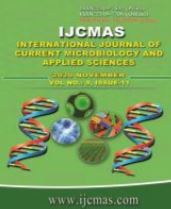


 National Academy of Agricultural Sciences (NAAS)
National Academy of Agricultural Sciences (NAAS)

|
PRINT ISSN : 2319-7692
Online ISSN : 2319-7706 Issues : 12 per year Publisher : Excellent Publishers Email : editorijcmas@gmail.com / submit@ijcmas.com Editor-in-chief: Dr.M.Prakash Index Copernicus ICV 2018: 95.39 NAAS RATING 2020: 5.38 |
A field experiment was conducted during Kharif 2019-20 at Agronomy section, College of Agriculture, Latur. The experiment was laid out in Randomized Block Design. The soil was clay loam in texture, low in available nitrogen (124.6 kg ha-1), low in phosphorus (17.3 kg ha-1), high in potash (496.7 kg ha-1) and alkaline in reaction (7.7 pH). The eight treatments were replicated thrice. The treatments were T1 : Full package of practices, T2 : T1 - RDF, T3 : T1 - Weeding, T4 : T1 - Plant Protection, T5 : T1 - (RDF + Weeding), T6 : T1 - (RDF + Plant Protection), T7 : T1 - (Weeding + Plant Protection), T8 : T1 - (RDF + Weeding + Plant Protection). The results clearly indicated that grain yield, stover yield (kg ha-1), seed index, harvest index (%), GMR, NMR (₹ ha-1) and B:C ratio were significantly influenced by application of all priority inputs. Treatment T1 Full package of practices (FPP) to Kharif maize recorded highest grain yield, stover yield (kg ha-1), seed index, harvest index (%), GMR, NMR (₹ ha-1) and B:C ratio and was found significantly superior over rest of the all treatments. Full package of practices (T1) was recorded higher gross and net monetary returns and B:C ratio. The treatment of T8 without any input treatments recorded significantly lowest grain yield, stover yield (kg ha-1), seed index, harvest index (%), GMR, NMR (₹ ha-1) and B:C ratio over all priority inputs treatments. Therefore, RDF is suggested to apply on a priority basis followed by weeding and plant protection.
 |
 |
 |
 |
 |